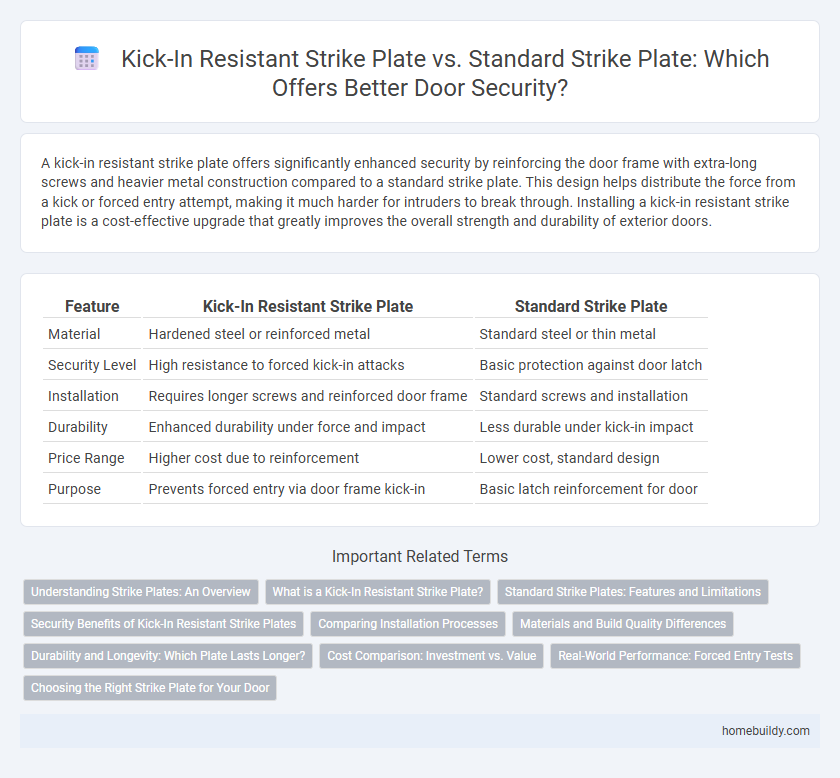A kick-in resistant strike plate offers significantly enhanced security by reinforcing the door frame with extra-long screws and heavier metal construction compared to a standard strike plate. This design helps distribute the force from a kick or forced entry attempt, making it much harder for intruders to break through. Installing a kick-in resistant strike plate is a cost-effective upgrade that greatly improves the overall strength and durability of exterior doors.
Table of Comparison
| Feature | Kick-In Resistant Strike Plate | Standard Strike Plate |
|---|---|---|
| Material | Hardened steel or reinforced metal | Standard steel or thin metal |
| Security Level | High resistance to forced kick-in attacks | Basic protection against door latch |
| Installation | Requires longer screws and reinforced door frame | Standard screws and installation |
| Durability | Enhanced durability under force and impact | Less durable under kick-in impact |
| Price Range | Higher cost due to reinforcement | Lower cost, standard design |
| Purpose | Prevents forced entry via door frame kick-in | Basic latch reinforcement for door |
Understanding Strike Plates: An Overview
Kick-in resistant strike plates are engineered with reinforced steel and extended mounting holes to enhance security by distributing force over a larger area, reducing the risk of door frame failure during forced entry attempts. Standard strike plates typically consist of thinner metal and shorter screws, offering basic protection but lacking the structural integrity to withstand high-impact kicks. Understanding the distinctions between these strike plates is crucial for improving door security and preventing break-ins effectively.
What is a Kick-In Resistant Strike Plate?
A kick-in resistant strike plate is designed with reinforced steel and longer screws to securely anchor the door frame, significantly increasing resistance against forced entry compared to standard strike plates. Unlike typical strike plates that only cover the latch area, these specialized plates extend protection over vulnerable points such as the hinge side, preventing door frame splitting during break-in attempts. Installing a kick-in resistant strike plate enhances home security by fortifying door jambs and distributing impact force more effectively.
Standard Strike Plates: Features and Limitations
Standard strike plates are typically made of thin metal and designed to align with the door latch, providing basic security by reinforcing the door frame around the latch area. These plates, often installed with short screws, offer limited resistance to forceful entry methods such as kick-ins, as they can bend or pull away from the frame under high impact. Their primary limitation is insufficient reinforcement of the door jamb, making them less effective in preventing break-ins compared to kick-in resistant strike plates engineered with thicker materials and extended screw lengths.
Security Benefits of Kick-In Resistant Strike Plates
Kick-in resistant strike plates enhance door security by reinforcing the frame with thicker steel and longer screws, making forced entry significantly more difficult compared to standard strike plates. These plates distribute the impact force more evenly, reducing the chances of the door frame splitting or breaking during an attempted kick-in. Installing a kick-in resistant strike plate can deter burglars and increase overall home protection by fortifying the most vulnerable point of a door.
Comparing Installation Processes
Kick-in resistant strike plates typically require reinforcing the door frame with longer screws and metal plates to ensure enhanced security, making the installation process more involved than with standard strike plates. Standard strike plates often install quickly using shorter screws and basic alignment, requiring minimal modifications to the door frame. The added steps and hardware in kick-in resistant installations can increase installation time but significantly improve door frame strength against forced entry.
Materials and Build Quality Differences
Kick-in resistant strike plates are constructed from hardened steel or reinforced metal alloys, significantly enhancing their strength compared to standard strike plates typically made from lighter steel or zinc. These heavy-duty materials are often thicker and feature longer screws designed to anchor deep into the door frame, providing superior resistance to forced entry. The build quality of kick-in resistant strike plates emphasizes durability and impact absorption, reducing vulnerability points common in standard models.
Durability and Longevity: Which Plate Lasts Longer?
Kick-in resistant strike plates are constructed from reinforced steel with extended screws that anchor deeply into door framing, providing superior durability compared to standard strike plates made from lighter materials. The heavy-duty design and robust mounting reduce the risk of wear and structural damage, ensuring a significantly longer lifespan under forced entry attempts. Standard strike plates, often thinner and less securely fastened, tend to wear out faster and fail under high-impact stress, resulting in reduced longevity.
Cost Comparison: Investment vs. Value
Kick-in resistant strike plates typically cost between $20 and $50, significantly higher than standard strike plates priced around $5 to $15. The increased investment in kick-in resistant plates offers enhanced security by reinforcing door frames to withstand forced entry attempts, potentially saving thousands in repair and insurance expenses after break-ins. Evaluating the cost against the value of safety and reduced risk highlights the long-term financial benefits of opting for superior strike plate protection.
Real-World Performance: Forced Entry Tests
Kick-in resistant strike plates outperform standard strike plates in forced entry tests by significantly increasing the door's resistance to high-impact kicks and lever attacks. Engineered with reinforced materials and longer screws, these strike plates distribute force more effectively, reducing door frame damage and improving security. Real-world testing shows they can withstand repeated impacts up to 2500 pounds of force, compared to standard plates which typically fail under 1000 pounds.
Choosing the Right Strike Plate for Your Door
Kick-in resistant strike plates feature reinforced steel construction and longer screws that penetrate deep into the door frame, significantly enhancing security against forced entry. Standard strike plates are typically thinner and installed with shorter screws, offering basic protection but vulnerability to kick-in attacks. Choosing the right strike plate involves assessing security needs, with kick-in resistant options recommended for exterior doors to prevent break-ins.
kick-in resistant strike plate vs standard strike plate Infographic

 homebuildy.com
homebuildy.com